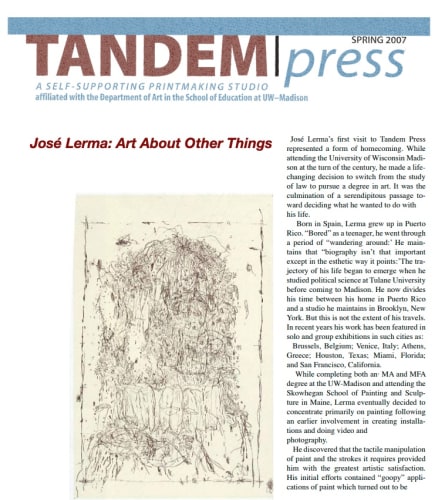José Lerma’s first visit to Tandem Press represented a form of homecoming. While attending the University of Wisconsin Madison at the turn of the century, he made a lifechanging decision to switch from the study of law to pursue a degree in art. It was the culmination of a serendipitous passage toward deciding what he wanted to do with his life.
Born in Spain, Lerma grew up in Puerto Rico. “Bored” as a teenager, he went through a period of “wandering around:’ He maintains that “biography isn’t that important except in the esthetic way it points:’The trajectory of his life began to emerge when he studied political science at Tulane University before coming to Madison. He now divides his time between his home in Puerto Rico and a studio he maintains in Brooklyn, New York. But this is not the extent of his travels. In recent years his work has been featured in solo and group exhibitions in such cities as: Brussels, Belgium; Venice, Italy; Athens, Greece; Houston, Texas; Miami, Florida; and San Francisco, California.
While completing both an· MA and MFA degree at the UW-Madison and attending the Skowhegan School of Painting and Sculpture in Maine, Lerma eventually decided to concentrate primarily on painting following an earlier involvement in creating installations and doing video and photography.
He discovered that the tactile manipulation of paint and the strokes it requires provided him with the greatest artistic satisfaction. His initial efforts contained “goopy” applications of paint which turned out to be José Lerma: Art About Other Things “too loaded, too heavy:’ As a result, Lerma wants his paintings to be “slow” in dimension and density.
Before he starts a painting, he usually makes a series of drawings. He recalls that in his childhood he made paintings of various people. Now, however, the paintings “feel like portraits but are not representational, not of anyone in particular:’ Because his paintings ultimately deal with his life and memories, the drawings “begin to look like something as the memory kicks in. Sometimes they take longer than the paintings because of the amount of information they contain:’ Lerma found that because of the he time spends on the exploratory drawings “most of the paintings become almost automatic and they almost always have some kind of cartoonish element:’ The drawing and painting aspects of his work are distinctively reflected in the prints he created during his visit to Tandem Press.
As he continues to pursue his career, Lerma has concluded that, “At some point, all art is about other things-and your parents:’ (A.H.)

